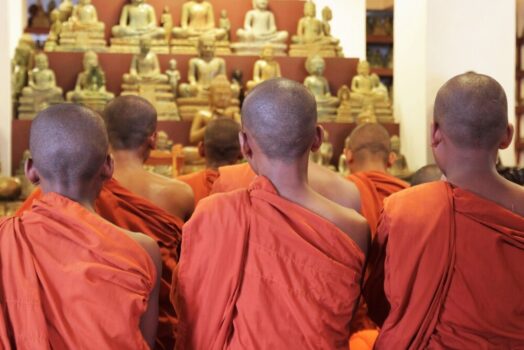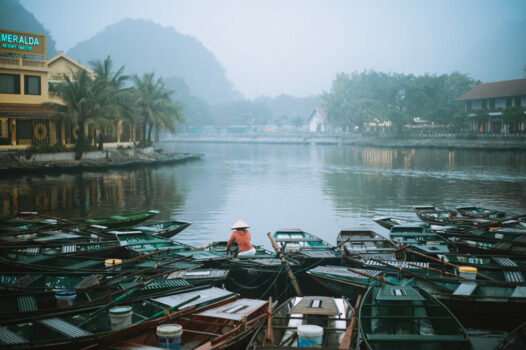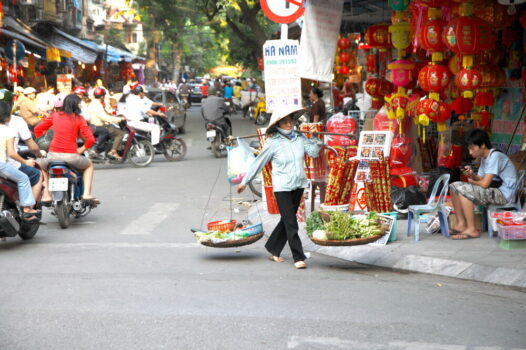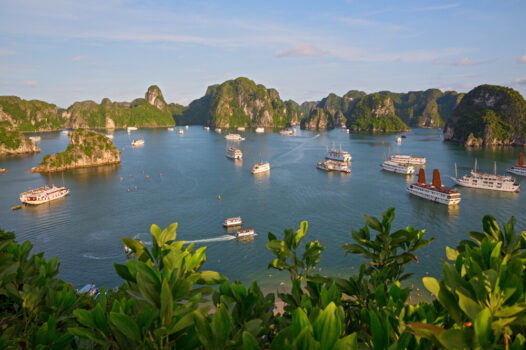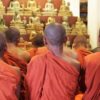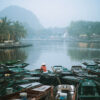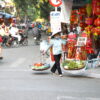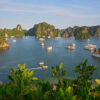Vietnam and Cambodia: Discovery Tour – Tried and Tested!
Lush landscapes, vivid colours and the locals’ infectious spirit, make this one of the world’s most beautiful and welcoming places. Discover Vietnam and Cambodia on this cultural tour for groups.
This region buzzes with energy and oozes ancient and colonial history. Additionally, South East Asia is world renowned for its flavourful and mouth-watering cuisine. The sights, smells and sounds of Vietnam and Cambodia are enough to make any traveller never want to leave.
Visit the impressive Angkor Wat temple, gorge on delectable street food from bustling markets, and cruise Ha Long Bay. Home to some of the most idyllic and secluded beaches in the world, South East Asia is the perfect place to relax and unwind.
Dates
Dates on request
Suggested Itinerary by Air
Day 1
Hanoi – Arrival
Fly from the UK and arrive at Noi Bai Airport. Enjoy the evening at leisure to relax in the hotel or explore the city.
Day 2
Hanoi – Cruise Ha Long Bay
The shuttle bus will pick you up at your hotel and depart for Ha Long Bay. Pass through the scenic countryside on the way to the wondrous Ha Long Bay, truly one of Vietnam’s most impressive scenic sights. Embark on a cruise to explore the legendary bay. Enjoy a fantastic view of the picturesque scenery. Some 3,000 limestone islands rise amazingly from the clear and emerald water. The limestone karst formations are littered with beaches, grottoes and beautiful caves. Along the way, anchor for a leisurely swim in a secluded cove and a visit to one of the many hidden grottoes beneath towering cliffs.
Day 3
Ha Long Bay – Relax on the beach surrounded by picturesque scenery
After breakfast on the boat, spend the morning swimming and sunbathing. After lunch, return to Hanoi and enjoy the afternoon at leisure.
Day 4
Hanoi – Da Nang – Hoi An
Travel to the historic complex of Ba Dinh. Visit Ba Dinh Square, where the late President Ho Chi Minh read Viet Nam’s Proclamation of Independence on 2 September 1945. Continue to Ho Chi Minh’s Mausoleum and the One-Pillar Pagoda, a must-see ancient Buddhist monument. Built in the early 11th century during the reign of King Ly Thai Tong, the pagoda resembles a lotus blossom. You will also visit Van Mieu – Quoc Tu Giam (temple of literature), the first Imperial school in Viet Nam built in 1070 during the dynasty of King Ly. Transfer to airport for flight to Da Nang. On arrival, you will be picked up and transferred to nearby Hoi An. Enjoy the fresh cool sea breeze with a leisurely evening stroll in the shimmering lights of the ancient town.
Day 5
Hoi An – Hue – Visit the Citadel
Upon arrival in Hue, visit the Citadel, Hue’s prime attraction, which contains the Imperial City, the Forbidden Purple City and the Emperor’s Private Residence. Take a boat trip on the Perfume River with a stopover at Thien Mu Pagoda. Considered by many as the unofficial symbol of Hue, Thien Mu is an active Buddhist monastery with origins dating back to 1601. One of its most poignant displays is a car belonging to a former monk, who in 1963, drove to Saigon and set himself alight to protest against the South Vietnamese regime and its cruel treatment of Buddhist monks and followers. From here, visit the serene Khai Dinh Royal Tomb, designed to blend in with its natural surroundings and built on principles of feng-shui.
Day 6
Hoi An – Foodie Tour
Discover Hoi An’s countryside and its local foods by bicycle. Start the tour with a ride to a local village. Stop off to enjoy a bowl of Cao Lau, a traditional Hoi An specialty composed of local noodles, pork, fresh vegetables and rice paper. The noodles are made with local sticky rice soaked in the water that must be taken from Ba Le Well: the oldest well in Hoi An, believed to have the best water anywhere. You will also learn how to make special white rose cakes with a local family and have the opportunity to taste them. Before the end of the tour, visit Cam Nam to enjoy the Ying and Yang food such as: Banh Dap and Che Bap.
Day 7
Hoi An – Da Nang – Ho Chi Minh City
Check out and transfer to Da Nang for your flight to Ho Chi Minh City. Pick up and transfer to the hotel. Evening at leisure to relax or explore the city.
Day 8
Mekong Delta – Cai Be floating market
Travel from Ho Chi Minh City to the Mekong Delta. Upon arrival, take a boat cruise to visit Cai Be Floating Market. The floating market is one of the most interesting and exciting attractions in the Mekong Delta. At the floating market, you can watch locals aboard their small boats trading fresh goods and local commodities. Stop over at a local house where you can see how they make coconut candy, rice-paper, rice-pop corn and rice wine. Leave Cai Be for Binh Hoa Phuoc Islet where the maze of shady creeks will surely fascinate you. You will have a chance to spend time with the local farmers, enjoying traditional music and tropical fruits. Enjoy a traditional lunch at a local home, including the popular dish of ‘Elephant Ear Fish’.
Day 9
Cu Chi Tunnels – Ho Chi Minh City Tour
Start the day with a visit to the famous Cu Chi Tunnels. Stretching over 250 km, Cu Chi is one of the most famous and historical aspects of war in Viet Nam. The tunnel system was created in 1948 to assist the Viet Minh as they fought the French for independence and became legendary during the 1960’s in playing a vital role in the Viet Nam War by allowing the Viet Cong (communist guerrillas) to control large rural areas, just 65 km away from Ho Chi Minh City. In the afternoon, visit some of the other major attractions in HCMC: the War Remnants Museum, Reunification Palace, Notre Dame Cathedral and Old Post Office.
Day 10
Ho Chi Minh City – Siem Reap
Transfer to the airport for your flight to Siem Reap. Upon arrival, pick up and transfer to the hotel. In the evening, explore the city and visit the Night Market and the popular Pub Street.
Day 11
Banteay Srei & Beng Mealea
One of the jewels in the Angkor area, Banteay Srei, dates back to the late 10th century. The enchanting temple is nearly everyone’s favourite site. The special charm of this temple lies in its remarkable state of preservation, small size and excellence of decoration. It was built by a Brahmin of royal descent who was a spiritual teacher to Jayavarman V, which is unique as this makes Banteay Srei the only major temple built by a non‐King. A special feature of the exquisite decoration was the use of hard pink sandstone. Continue afterwards to Beng Mealea, which was built between the late 11th and the first half of the 12th century and is one of the largest ensembles in the Angkor region. Enjoy a picnic lunch before exploring the massive grounds.
The temple is regarded as a standalone masterpiece situated 40km east of the main temples of Angkor along the ancient road that connected the Angkor Kingdom with Prasat Bakan. It is assumed that King Suryavarman II ordered the construction of Beng Mealea, maybe even as a prototype of its larger brother; Angkor Wat, but no actual proof can be found in its depictions. The ruins of Beng Mealea are overgrown with vegetation, allowing a real “wilderness experience.” In recent years a wooden pathway has been constructed throughout the temple to allow people to observe the beauty of the temple in ease. However, most people venture of the beaten track and find their own way through the temple allowing them to experience the feeling the first explorers must have felt when they uncovered this magnificent structure.
Day 12
Siem Reap – Angkor Temples
Spend the day visiting the well-known Temples of Angkor Archeological Park. Wake up early to witness the beautiful sunrise at Angkor Wat or Ta Prohm. Then back to hotel for breakfast and continue the tour to visit: Southern Gate of Angkor Thom, Angkor Wat and Ta Prohm.
Day 13
Siem Reap – Phnom Penh
After breakfast at the hotel, you will be transferred to airport for your flight to Phnom Penh.. Upon arrival you will be picked up and transferred to the hotel. Check in and relax.
Day 14
Phnom Penh – City Tour
The Royal Palace was built by the French in 1866 on the site of the old town. The main building on the compound is the Throne Room. It was built in 1917 in the traditional Khmer style and has a tiered roof and a 59‐meter tower, which is influenced by Angkor Thom’s Bayon Temple. On the compounds of the Royal Palace, the Silver Pagoda stands out in its own distinctive way. The Pagoda’s steps are made of Italian marble. On the inside the floor is comprised of more than 5000 silver tiles, which together weigh nearly 6 tons. The pagoda houses a magnificent 17th century Emerald Buddha statue and a 90kg gold Buddha studded with 9584 diamonds. Right next to the palace, the National Museum of Phnom Penh was designed by French historian George Groslier also following traditional Khmer architecture. Finally visit the Wat Phnom located on a man‐made hill, 27m high.
Day 15
Phnom Penh – Departure
Check out, and transfer to the airport for your return flight to the UK.
Both countries are subject to two main seasons, wet and dry, but they can still be visited and enjoyed all year round. The dry season, from November to April, is the most popular time to visit both countries, but the wet season isn’t as bad as the label implies, and can actually be a pleasant time to go thanks to lower visitor numbers.
Visa Requirements – Vietnam:
You can get an e-visa for Vietnam online for visits of up to 30 days, the visa is limited to certain entry and exit points but you will be asked to specify these when applying for the visa. For visas longer that 30 days contact the nearest Vietnamese embassy.
Visa Requirements – Cambodia:
Tourist Visas are available on arrival at the main Cambodian airports for $30 and you will also need to arrive with a passport photograph, Visa’s can also be bought online. The visa usually lasts for 30 days, overstaying this can lead to fines and deportation.


